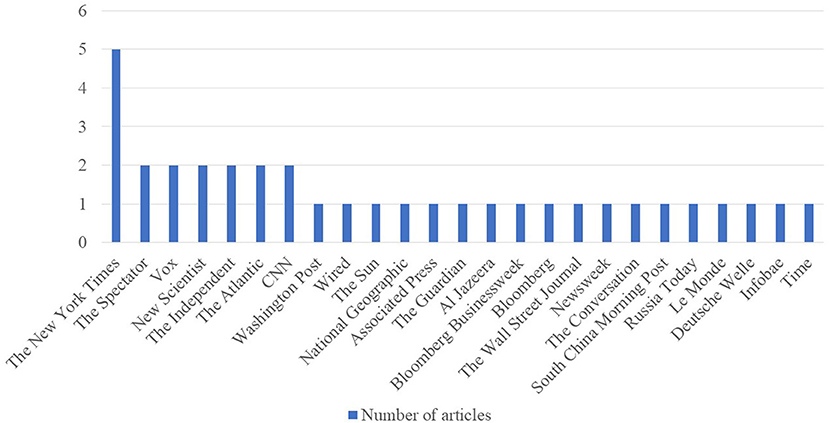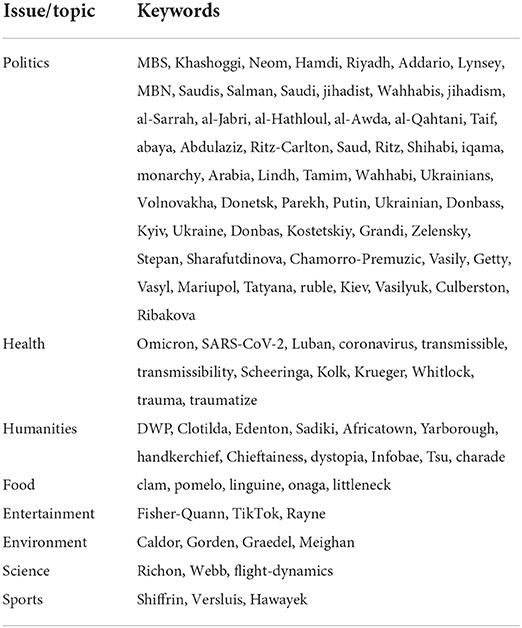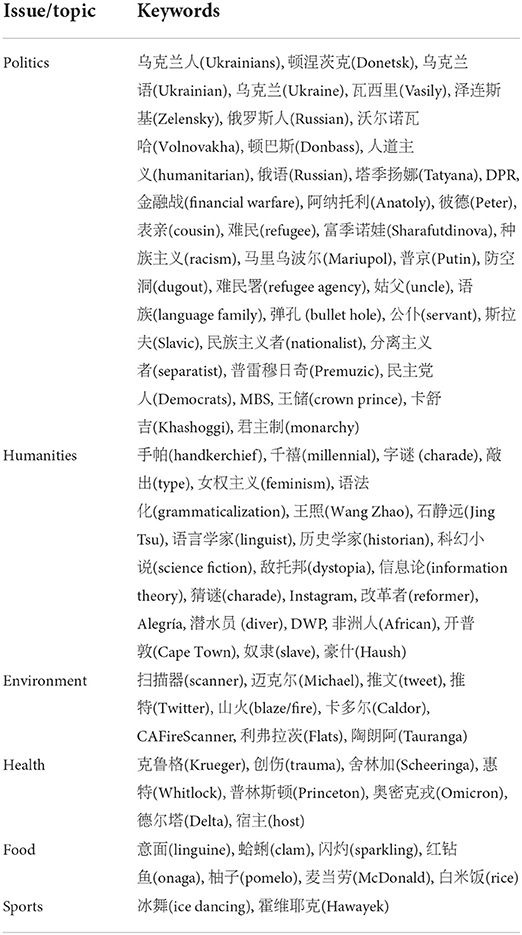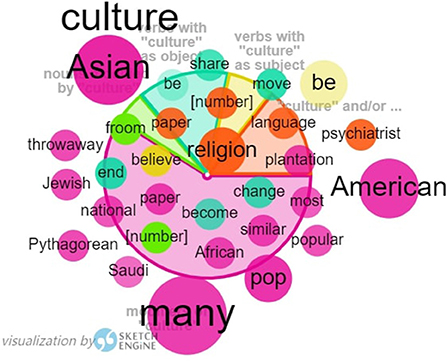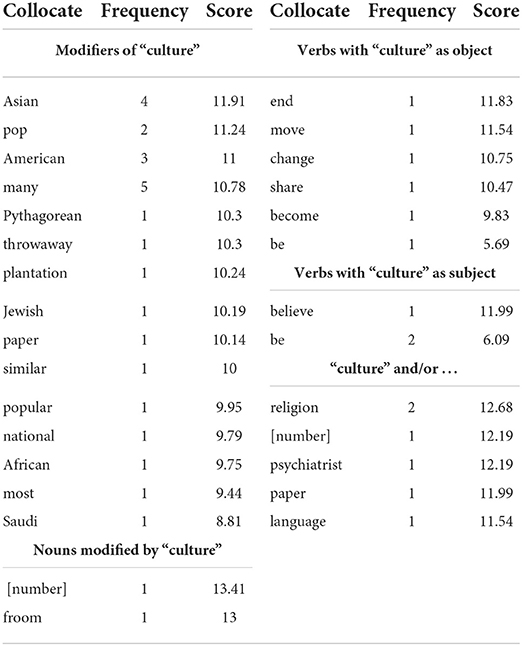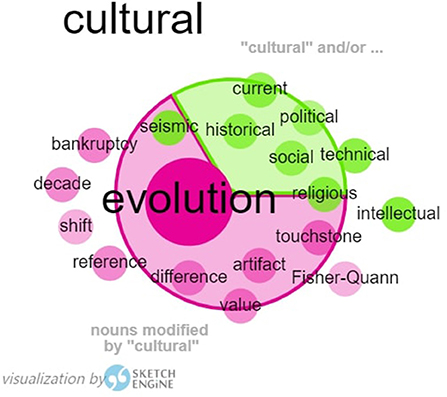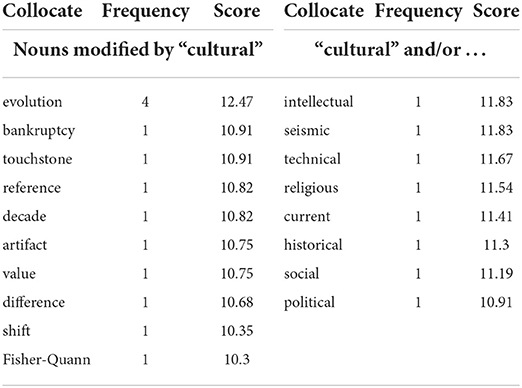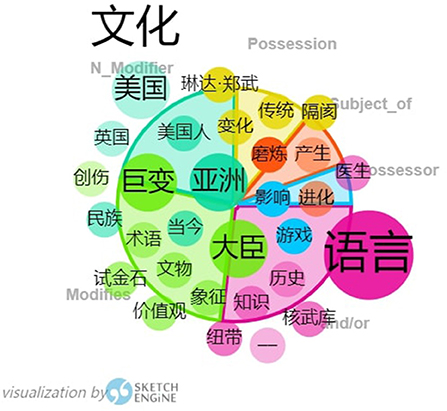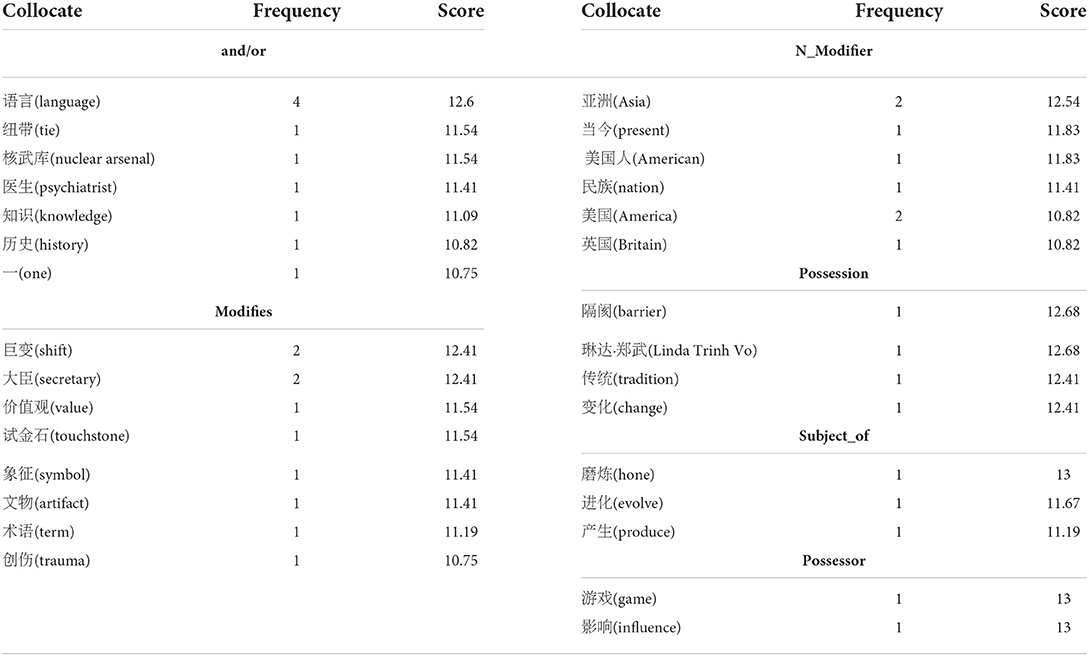- Centre for Translation Studies, School of Foreign Languages, Hangzhou Dianzi University, Hangzhou, China
Drawing on the notion of cultural translation and agenda-setting theory, this study examines the role that translation plays in facilitating cross-linguistic and cross-cultural communication within the context of news translation. It is based on a case study of Culture Weekly—a four-page section published every Monday in Reference News, the most widely circulated daily newspaper in China. This study analyzes a comparable corpus of Chinese news articles from Culture Weekly and their English-language versions from various media outlets between February and March 2022. The study finds that the newspaper mainly used strategies of acculturation and literal translation and that it set the agenda for its domestic readers by highlighting particular cultural issues and disseminating certain cultural values. This case study provides insight into how news translation, as a form of recontextualization, strikes a delicate balance between accuracy and acceptability and how it mediates between source and target cultures within the institutional setting. The resulting translation reflects the editorial attitudes of the media outlet toward various cultural issues and manifests the relationship between the newspaper and its readership.
Introduction
There has been increasing emphasis on examining the contexts of translation from a cultural studies perspective since the cultural turn in translation studies (Bassnett and Lefevere, 1998). A growing body of literature has recognized the importance of culture in translation (e.g., Liddicoat, 2016; Katan and Taibi, 2021; Valdeón, 2021). These studies point out that translation is not only an interlingual but also an intercultural or cross-cultural act. They argue that translation is cultural mediation and the translator is a cultural mediator playing a critical role in communication. This is particularly evident in news translation, since it is pivotal to cross-cultural communication in the context of globalization.
Many studies in the field of news translation have focused on the effects of the media on news translation, especially in relation to gatekeeping (Vuorinen, 1995; Song, 2017; Valdeón, 2021, 2022) and framing (Valdeón, 2014; Wu, 2018; Liu, 2019). To date, few studies have investigated the effects of translation on agenda-setting in cross-cultural communication. As Valdeón (2021, p. 34) suggests, “agenda-setting could contribute to revealing some of the factors that affect the nature of translation as ‘mediation' and how these factors shape personal, collective and institutional narratives”. This paper presents a case study which examines agenda-setting in translated news articles in Culture Weekly, a four-page section published every Monday in Reference News (RN) and the role of news translation as cultural mediation in setting the news agenda for its readers.
The paper firstly gives a brief overview of the recent literature on agenda-setting and news translation as recontextualization and a cultural activity. The next section provides details on the corpus and methodology used. The next presents the findings from the corpus analysis before discussing the factors that contribute to the agenda-setting function of news translation.
Agenda-setting theory
Research into agenda-setting has a long history. The notion of agenda-setting was first discussed by Lippmann (1922) and popularized in his Public Opinion, in which he describes “the world outside and the pictures in our heads” (p. 3), although Lippmann (1922) did not call this phenomenon agenda-setting. The first serious analysis of agenda-setting was McCombs and Shaw (1972), which outlined the agenda-setting function of mass media and tested the hypothesis that “the mass media set the agenda for each political campaign, influencing the salience of attitudes toward the political issues” (p. 177, italics in original). The term “agenda” refers to “issues or events that are viewed at a point in time as ranked in a hierarchy of importance” (Rogers and Dearing, 1988, p. 556). The agenda-setting process has three main components: the media agenda, the public agenda, and the policy agenda (Rogers and Dearing, 1988). Researchers distinguish agenda-setting from agenda-building. Rogers and Dearing (1988, p. 556) argue that agenda-setting is “a process through which the mass media communicate the relative importance of various issues and events to the public”, whereas agenda-building is “a process through which the policy agendas of political elites are influenced by a variety of factors, including media agendas and public agendas”.
It is generally held that there are two levels of agenda-setting (Rogers et al., 1993). As McCombs and Ghanem (2001, p. 68) note, “[t]he first level of agenda-setting is the transmission of object salience, and the second level is the transmission of attribute salience”. In agenda-setting theory, an issue is defined as “a social problem, often conflictual, that has received mass media coverage” (Dearing and Rogers, 1996, p. 3) and salience is described as “the degree to which an issue on the agenda is perceived as relatively important” (Dearing and Rogers, 1996, p. 8). The first level of agenda-setting relates to the salience of issues from media agenda to public agenda. The second level of agenda-setting relates to attributes of a process regarded as framing by some scholars (McCombs and Ghanem, 2001). However, other scholars argue that second-level agenda-setting is not equivalent to framing. Weaver (2007, p. 145) argues that “[t]here are similarities between second-level agenda-setting and framing, even if they are not identical processes”. Both framing and agenda-setting are concerned with “how issues or other objects … are depicted in the media than with which issues or objects are more or less prominently reported” (Weaver, 2007, p. 145, italics in original). However, framing includes “a broader range of cognitive processes” (Weaver, 2007, p. 146) than agenda-setting. Agenda-setting and framing are different in several aspects, including in relation to news production, news processing and locus of effect (Scheufele and Tewksbury, 2007).
Extensive research on agenda-setting has been carried out in media communication and political communication, and a few studies have examined agenda-setting in other contexts (Kosicki, 1993; McCombs, 2005; McCombs et al., 2014). McCombs and Reynolds (2009, p. 13) point out that “[t]he transmission of culture is also linked to the agenda-setting process”. Several studies have analyzed the setting of cultural agenda in the salient attributes in the cultural domain (e.g., Bantimaroudis et al., 2010; Zyglidopoulos et al., 2012; Bantimaroudis and Zyglidopoulos, 2014; Symeou et al., 2015).
Scholarly interest in news translation is primarily focused on framing as a media effect, but this is just one effect among many others. Agenda-setting and priming, for example, are two similar yet distinct concepts which journalism scholars have applied to the analysis of news coverage (Iyengar and Simon, 1993). However, whether translation has an influence on agenda-setting remains unclear and has not yet received much attention in translation studies. News translation sets the agenda of original news coverage and affects the attitudes of recipients toward the subject discussed. This study explores this intersection between translation studies and communication from the perspectives of cultural agenda-setting and examines whether and/or to what extent the salience of cultural issues and attributes in a source text (ST) is transferred to a target text (TT).
News translation as recontextualization and socio-cultural activity
The term “recontextualization” can be traced back to Bernstein (1990) who used it to describe the transfer of knowledge in relation to pedagogic discourse. Its meaning has broadened from its original definition within discourse studies and has been defined as “the dynamic transfer-and-transformation of something from one discourse/text-in-context (the context being in reality a matrix or field of contexts) to another” (Linell, 1998, p. 144–145). Critical discourse analysts refer the term to “a relationship between different (networks of) social practices—a matter of how elements of one social practice are appropriated by, relocated in the context of, another” (Fairclough, 2003, p. 222). They argue that discourse as “recontextualization of social practice” (Van Leeuwen, 2008, p. 4) plays a critical role in the construction of social reality. Some translation scholars argue that translation is a form of recontextualization that transfers the meanings from STs to TTs (Greenall and Løfaldli, 2019). News translation is a recontextualization practice which is “a complex site of institutional goals and procedures, coupled with tension and conflict among different representations, ideologies and voices” (Kang, 2007, p. 219). These studies indicate that recontextualization is an important concept for news translation research and highlight a critical role for recontextualization in news translation.
The consideration of cultural aspects is common in news translation research and yet culture is a concept difficult to define precisely. Culture is a broad concept which encompasses different aspects, such as “the arts and artistic activity; the learned, primarily symbolic features of a particular way of life; and a process of development” (Longhurst et al., 2008, p. 2). There has been increasing emphasis on examining the contexts of news translation in the target culture and this cultural approach analyzes news translation beyond the textual level. Conway states that news translation is “a key site of mass mediated intercultural contact” (Conway, 2010, p. 979) and considers news translation to be a form of cultural translation by which “journalists try to explain to one group how another sees the world” (Conway, 2012a, p. 998). This definition of cultural translation is a “process of understanding” (Conway, 2012b, p. 272) which goes beyond the traditional view of translation as mere linguistic transformation. However, this distinction between linguistic and cultural translation is opposed by Davier (2015), who argues that the very notion of translation is itself linguistic and cultural and that the concepts of “cultural translation” (Conway, 2015) and “acculturation” (Bassnett, 2005) are unnecessary and illegitimately prescriptive. Davier (2015) advocates a broader definition of translation in news agencies and proposes a methodological triangulation of textual, fieldwork and corpus analysis in a study of how multicultural readers of Agence France-Presse and Agence Télégraphique Suisse understand Switzerland as the cultural other.
The cultural approach to news translation addresses the significance of translators and/or journalists in a broader social and cultural context. Conway and Vaskivska (2010) state that news translation contributes to better cross-cultural communication. Conway (2008) proposes a circuit model of culture in news translation, linking it to various elements such as cultural artifact, production, reception and socio-historical context. The studies so far reviewed here mainly view news translation as a socio-cultural activity, but the mechanisms for the transfer of cultural elements from one text to another have not been sufficiently researched. This study explores the role played by translation in setting the agenda of various cultural issues and attributes between the STs and TTs and seeks to address the following research questions (RQs):
RQ1: What are the salient cultural issues in the English and Chinese news? Is the salience of cultural issues in the English news transferred to the issue agenda in Culture Weekly?
RQ2: What are the salient attributes of these cultural issues in the English and Chinese news? Is the salience of cultural attributes in the English news transferred to the attribute agenda of Culture Weekly?
RQ3: What are the contributing factors that cause any differences in salience?
Corpus and methods
Corpus
A small ad hoc comparable corpus was built for the Chinese and English articles on Sketch Engine, an online corpus software. The Chinese and English news articles were firstly converted into plain text format then formatted and noise eliminated. The Chinese texts were segmented by the CoreNLP tokenizer in Sketch Engine. The Chinese and English news texts were then compressed into an archive file and each uploaded to Sketch Engine.
The corpus consists of 35 pairs of translated Chinese articles from Culture Weekly (CW) and their original versions from various English-language media outlets. The Chinese articles were published in the eight issues of CW published in Reference News (RN) between February and March 2022. Several globally significant issues occurred during this period. Of particular relevance here are the Beijing Winter Olympics and Paralympics because they naturally attracted high global media attention and were a stage for displaying Chinese culture. The Russia-Ukraine conflict also broke out in this period.
The articles selected for this study were chosen because their sources of information and publication dates were identifiable, making it easy to identify their STs. The sources are presented in Figure 1. Five articles were selected from the New York Times, making it the most frequent source. Two articles each were chosen from the Spectator, New Scientist, Independent and Atlantic journals' websites and the Vox and CNN websites. The other 18 articles come from a range of global media. Most of these articles are in English, with the rest in French, Spanish, or German. The STs were retrieved by searching online for the media outlet, date of publication and news headlines provided at the beginning of translated articles in CW. The headlines of STs and TTs are listed in the Supplementary material.
The English subcorpus consists of 80,515 tokens or 68,685 words, whereas the Chinese subcorpus contains 37,410 tokens or 31,576 words. Thus, the size of the Chinese subcorpus is less than half (46%) that of the English subcorpus, which may be attributable to the omission of parts of the texts, given that “omission is a key strategy in the translation of news items, where material is tailored to the needs of a specific local audience” (Bielsa and Bassnett, 2009, p. 8). Table 1 provides the details.
Methods
Researchers in agenda-setting mainly employ traditional methods such as content analysis and manual coding to identify media and public agendas. As Dearing and Rogers (1996, p. 18) note on the measurement of agendas, “[t]he media agenda is usually indexed by a content analysis of the news media to determine the number of news stories about an issue or issues of study”. With the rapid growth of online media, researchers adopt innovative methods such as “big data” to explore agenda-setting in media spheres (Neuman et al., 2014). The present big data-based study utilizes MonkeyLearn, a text analytic tool powered by artificial intelligence and natural language processing to examine the comparable corpus, identifying keywords and conducting collocation analysis.
The analysis is conducted at two levels. First-level agenda-setting examines the cultural issues in the English and Chinese news respectively. The study employs the corpus tool of keywords analysis to identify the most salient keywords from the STs and TTs and classifies these keywords into various cultural issues. The term “keyword” is used in corpus linguistics to mean “a word that is more frequent in a text or corpus under study than it is in some (larger) reference corpus” (McEnery and Hardie, 2012, p. 245). The word list of the English subcorpus is compared to that of the reference corpus English Web 2020 (enTenTen20). Likewise, the word list of the Chinese subcorpus is compared to that of the Chinese Web 2017 (zhTenTen17). These keywords were classified by the topic classifier in MonkeyLearn which automatically detect topics in text data. This was then followed by a second-level agenda-setting analysis of the salient cultural attributes in the English and Chinese news agendas. The word sketch corpus tool compared the collocation of key cultural attributes in English and their equivalents in the Chinese news agenda, as described in Kilgarriff and Tugwell (2001). The collocates of these attributes were examined in their contexts to identify patterns of translation strategy.
Results
First-level agenda-setting
Table 2 illustrates the top 100 keywords in the English news subcorpus. These keywords mainly fall into the eight topic categories of politics, health, humanities, food, entertainment, environment, science, and sports. Over half of the keywords relate to politics, making it the most salient issue in the English news agenda. These keywords relate mainly to two political matters: the activities of the Saudi crown prince and the Russia-Ukraine conflict. A total of 32 keywords come from “Absolute Power”, an article about Saudi Arabian Crown Prince Mohammed bin Salman published in the April 2022 issue of the Atlantic. The Russia-Ukraine conflict, which started in February 2022, generated 26 related keywords. The second most salient issue in the English news is health. Six keywords on COVID-19 originate from an article published in Time in January 2022 (Park, 2022). An equal number of keywords were derived from a Vox story in January 2022 (Pandell, 2022). The third most prominent topic in the English news agenda is humanities. Six keywords are from a story which appears in the March 2022 issue of National Geographic magazine. A few topics related to humanities, such as the history of the handkerchief, science fiction, the tragic deaths of famous persons, and the evolution of Chinese characters. The food topic features five keywords from three recipes. The entertainment topic is marked in a Vox article about how Rayne Fisher-Quann, a famous writer and cultural critic on TikTok, spends her day online. Environment issues such as climate change and waste recycling are highlighted in two articles, including one about Thomas Graedel, a professor of industrial ecology at Yale University, and the other about the Caldor Fire in California and Thomas Gorden, a member of Fire Twitter. The science issue is featured in an article in the Atlantic about Karen Richon, an aerospace engineer at NASA Goddard Space Flight Center. The sports topic occurs in just three keywords relating US skier Mikaela Shiffrin, Finnish ice dancer Matthias Versluis, and US ice dancer Kaitlin Hawayek being interviewed about the food they ate in the Beijing Winter Olympic village.
Table 3 shows the top 100 keywords in the Chinese subcorpus. These keywords mainly fall into the six topic categories of politics, humanity, environment, health, food and sport. In the Chinese news, political issues are still the most prominent, with a total of 33 keywords featuring the Russia-Ukraine conflict and four keywords featuring the Saudi crown prince. The environmental issue of wildfire is highlighted with nine keywords from an article in Wired. The health issues of trauma and COVID-19 were discussed in two articles in Vox and Time with five and three keywords respectively. Food topics, such as the recipes already mentioned, reoccur. Besides these, the closing of McDonald's restaurants in Russia as a result of the war in Ukraine and rice as a popular food with foreign athletes in the Olympic village were presented. Like the English news, the sports topic has the least prominence on the Chinese news agenda, with two keywords featuring ice dancing athletes from Spain and the Czech Republic, and the US ice dancer Kaitlin Hawayek.
Political issues rank among the first issues in both the English and Chinese news agendas. The Russia–Ukraine conflict was a political issue that is both salient in the English and Chinese news agenda. The activities of the Saudi crown prince were another political issue that is salient in the English news agenda with 32 keywords. However, it is less salient in the Chinese news agenda, with five keywords. The issue of the Saudi crown prince's activities received considerably less attention in the Chinese news agenda than in the English one. The royal attributes are largely maintained, with a set of keywords representing monarchical power, whereas the cultural attributes are greatly undermined, with only a few keywords on the historic and political attributes. The environmental issue of wildfire is given more prominence, whereas waste recycling receives less. The health issues of COVID-19 and trauma had less emphasis in the Chinese news agenda than its English counterpart, particular in the case of the issue of trauma. The topic of food was given slightly more attention in the Chinese agenda.
Second-level agenda-setting
This subsection compares the salient attributes of the cultural issues in the English and Chinese news agenda and examines whether the salience of cultural attributes in the English news is transferred to the attribute agenda of the Chinese news. It compares the collocations of “culture” and “cultural” and their Chinese equivalent “文化” (culture) in the English and Chinese subcorpora. These examples were selected to discuss instead of others because they are prominent collocates and examples are presented to show how these collocates are translated in specific contexts.
Figure 2 shows the word sketch of “culture” in the English subcorpus. Table 4 illustrates the scores and frequencies of these collocates in the English subcorpus. “Culture” appears 33 times in the English subcorpus and mainly collocates with words in five categories. The modifiers of “culture” include “many”, “Asian”, “pop” “American”, and so on. Regional or national cultures like African cultures or Saudi and religious cultures such as Christian, Islamic and Jewish are represented in the English news. “Culture” also encompasses popular and “throwaway” culture, as well as subcultures of a specific historical period, like Pythagorean culture and plantation culture. This word often collocated with others like “religion” and “language”. Culture is often placed on an equal footing with religion and language, as the roles of all of these are important in society.
The adjective “cultural” occurs 17 times in the English subcorpus. The word sketch of “cultural” in the English subcorpus falls into two categories, as shown in Figure 3. The scores and frequencies of the collocates of “cultural” in the English subcorpus are shown in Table 5. The nouns modified by “cultural” are “evolution”, “bankruptcy”, “touchstone”, “reference”, “decade”, “artifact”, “value”, “difference”, “shift”, “Fisher-Quann”, “term”, “trauma” and “language”. “Evolution” is the most frequent noun modified by “cultural” in the English subcorpus. The adjectives used together with “cultural” are “intellectual”, “seismic”, “technical”, “religious”, “current”, “historical”, “social” and “political”.
The Chinese equivalent “文化” (culture) occurs 32 times in the Chinese subcorpus, almost the same number as in its English equivalent. Figure 4 shows the word sketch of “文化” (culture) in the Chinese subcorpus falling into six categories. The frequency and score of its collocates in the Chinese subcorpus are shown in Table 6. The nouns which are used to adjectivally modify “文化” (culture) are “亚洲” (Asia), “美国” (America), “当今” (present), “美国人” (American), “民族” (nation), and “英国” (Britain). “文化” (culture) is used together with phrases including “语言” (language), “纽带” (tie), “医生” (psychiatrist), “知识” (knowledge), and “历史” (history). “文化” (culture) modifies “巨变” (shift), “大臣” (secretary), “价值观” (value), “试金石” (touchstone), “象征” (symbol), “文物” (artifact), “术语” (term) and “创伤” (trauma). The other nouns in possessive constructions with “文化” (culture) are “隔阂” (barrier), “琳达·郑武” (Linda Trinh Vo), “传统” (tradition) and “变化” (change).
The word sketches of “culture” and “cultural” and their Chinese equivalent “文化” (culture) represent the cultural attributes in the English and Chinese news agenda. Some cultural attributes of the English news agenda were maintained in the Chinese agenda. As Example 1 shows, one New York Times article says that there are many kinds of cultures, the most prominent of which are Asian, American and Asian American cultures. As most of RN's readers are Chinese, its translated article maintained this cultural attribute by translating it faithfully to “亚裔美国文化” (Asian American culture), thus maintaining the cultural attribute that resonates with the readers.
Example 1
ST1: “It's hard in many Asian American cultures to say the words ‘I love you,”' she said, “so they do it through serving these special delicacies.” (The New York Times, 29 January 2022).
TT1: 她说:“在许多亚裔美国文化中,‘我爱你'这几个字很难说出口,所以,他们通过这些特别的美味来表达爱意。” (RN, 7 February 2022).
Gloss: “In many Asian American cultures, the words ‘I love you' are hard to say, so they express their love through these special delicacies,” she said.
As Figure 3 shows, one of the most frequent nouns modified by “cultural” is “evolution”. Examples 2 and 3 show two of the four instances of “cultural evolution” which occur in a New Scientist 26 March cover story about how languages evolve. These two examples relate the evolution of languages to cultural evolution which is translated into “文化进化” (cultural evolution) or “文化的进化” (cultural evolution) in the two instances in the corresponding 28 March RN article.
Example 2
ST2: If languages are honed by cultural evolution, through generations of improvised charade playing, that also explains why children can acquire their native tongue with such apparent ease. (New Scientist, 26 March 2022).
TT2: 如果语言是通过几代人即兴猜字游戏的文化进化磨炼出来的,这就解释了为什么孩子们可以如此轻松地掌握母语。 (RN, 28 March 2022).
Gloss: If language has been honed through generations of cultural evolution of improvised word-guessing games, that explains why children can master their native language so easily.
Example 3
ST3: We believe the answer is culture: language evolution is cultural evolution. (New Scientist, 26 March 2022).
TT3: 我们认为答案是文化:语言的进化就是文化的进化。 (RN, 28 March 2022).
Gloss: We think the answer is culture: the evolution of language is the evolution of culture.
Some cultural attributes of the original news agenda regarding popular cultures were omitted in the translated news agenda, as is shown in Example 4 from a Deutsche Welle article about the meaning of numbers, which was originally written in German and translated into English. However, the mention of pop culture in the middle of the sentence was omitted as well as the name of the director Sean Cunningham at the end of the sentence. This might be because the movie is the only example of pop culture in this sentence and the film director may not be familiar to the Chinese readers.
Example 4
ST4: Friday the 13th is not only unpopular among brides and grooms: it has also been ingrained in pop culture, most famously via the 1980 horror film of the same name directed by Sean Cunningham. (DW, 22 February 2022).
TT4: 13日星期五不仅不受新娘和新郎的欢迎–美国有一部叫《13日星期五》的同名电影,就能说明情况。 (RN, 28 March 2022).
Gloss: Not only is Friday the 13th unpopular with brides and grooms – there's a movie of the same name in America called Friday the 13th, which illustrates the situation.
The religious attributes of the cultural agenda in the Chinese news are greatly downplayed in the Chinese versions. When “culture” occurs with “religion”, it is not translated into Chinese, as is shown in Examples 5 and 6. Example 5 is from a Newsweek cover story about the Ukraine refugee crisis which quotes the deputy director of an NGO describing Ukrainians as sharing cultural and religious connections with Europeans. Example 6 quotes author Udo Becker comparing the meanings of numbers in different cultures and religions. These two sentences are not translated into the Chinese versions.
Example 5
ST5: Benjamin Ward, deputy director of Europe and Central Asia for Human Rights Watch, says that non-Ukrainian nationals, including people from Afghanistan and India, have weaker legal positions at European borders and might not be received as openly and kindly as Ukrainians who mostly share similar cultures and religion with Europeans. (Newsweek, 5 March 2022).
TT5: omitted.
Example 6
ST6: Author Udo Becker says in his work “Lexicon of Symbols,” that numbers “in most cultures and religions are symbol carriers with meanings that are rich, often complicated and not always transparent today.” (DW, 22 February 2022).
TT6: omitted.
The linguistic attribute in the Chinese news agenda is strengthened. When “culture” occurs with “language”, it is translated into Chinese in the way shown in Example 7 from the Wall Street Journal review of Kingdom of Characters on the history of Chinese characters. “文化” (culture) and “语言” (language) are used together in a similar footing, as is shown in Example 8 from an Independent piece about the TV show “Servant of the People” that features now-Ukrainian President Volodymyr Zelensky. “Cultural” and “language” are used together as a modifier for “barriers”, which is translated into “语言和文化的隔阂” (language and cultural barriers) in Chinese.
Example 7
ST7: Today the world is suddenly interested in learning about China's language and culture. (The Wall Street Journal, 1 March 2022).
TT7: 今天,世界突然对学习中国的语言和文化产生兴趣。 (RN, 7 March 2022).
Gloss: Today, the world is suddenly interested in learning Chinese language and culture.
Example 8
ST8: The show is very funny, even with language and cultural barriers. (The Independent, 3 March 2022).
TT8: 尽管有语言和文化的隔阂,这个剧还是很好玩。 (RN, 7 March 2022).
Gloss: Despite the language and cultural barriers, the show is fun.
Example 9 from the New York Times describes close cultural and linguistic bonds between Russia and Ukraine. The adverbs “culturally” and “linguistically” were translated as “在文化和语言上” (culturally and linguistically) in Chinese.
Example 9
ST9: We in the south of Russia weren't just physically close to Ukraine — my grandmother was born in the Ukrainian city of Mariupol, just 70 miles away — we were culturally and linguistically intertwined. (The New York Times, 22 February 2022).
TT9: 我们生活在俄罗斯南部, 不仅在地理上毗邻乌克兰—我的祖母出生在仅 70英里外的乌克兰城市马里乌波尔—我们在文化和语言上也交织在一起。 (RN, 28 February 2022).
Gloss: We live in southern Russia, not only geographically adjacent to Ukraine — my grandmother was born in the Ukrainian city of Mariupol just 70 miles away — we are also culturally and linguistically intertwined.
Discussion
Editorial attitudes toward cultural issues
This paper has argued that news translation, as a form of recontextualization, performs the agenda-setting function in the case of CW. Translation sets the agenda of the original news texts for the readers of the TTs. When translated into Chinese, the salience of cultural topics in the English news is mostly transferred into the issue agenda of CW. Some of the cultural topics were given more prominence, such as the linguistic attribute, whereas the religious attribute is greatly undermined in translation. A possible explanation for this may lie in the news outlet's editorial policy, which discourages the dissemination of religious beliefs among its domestic readers. However, the findings of the current study do not support those of Cheng et al. (2016) that limited salience of issues and attributes occurs between the news produced by Xinhua News Agency (XNA) and the US news outlets. This result may be explained by the fact that the data examined in Cheng et al. (2016) are not necessarily translations.
As XNA runs RN and heavily regulates the views expressed in it. Many regard XNA as an agent of the Chinese central government and the Communist Party of China (CPC). The current study has found that the translated news in CW clearly aligns with the central government's view on various cultural issues. This finding supports previous studies of the ideological positioning of RN's translation practices (e.g., Pan, 2014; Xia, 2019; Pan and Liao, 2021). The newspaper strictly adheres to the XNA style guide which bans the cultural use of sensitive words in relation to religion. This may be because, as Shirk (2011, p. 24) suggests, that XNA “has undergone a remarkable makeover” in recent years in order to compete with emerging commercial media outlets. These results also accord with He's (2003, p. 198) findings which showed that the Chinese media bodies, including XNA, employ a discursive strategy of “ideological re-pitching” which commingle the narrative of “order” with communist ideology and maximize patriotic sentiment.
Relationship between the newspaper and its readership
Consistent with previous ones (e.g., Wu, 2018; Xia, 2019), this study has found that translated news in RN undergoes a recontextualization process. RN translators are often required to recontextualize their textual productions to make them suitable for their diverse readerships and the target culture (Davies, 2006). Rogers and Dearing (1988, p. 571) note that “[m]edia gatekeepers have a general idea of the news interests of their audience, and this perceived priority of news interests is directly reflected in the news values with which media personnel decide the media agenda”. The media outlet converts news articles designed for another, largely foreign, readership and rewords them for readers in different environments who may have different ideological and linguistic backgrounds. Thus, many ideological and linguistic shifts are likely to occur during this process of news translation. The original news is intended for readers of English who are mostly outside the Chinese mainland. The readership of translated narratives in RN is mainly Chinese mainland residents. RN also runs an official website and social media platforms accessible around the world, but much of the material online differs from that which is in the newspaper (Zeng and Li, 2021). RN readers are mostly members of the CPC or government cadres who have received higher education. Hence, one could reasonably argue that the newspaper is a party mouthpiece creating articles which cater for its clientele's reading habits.
Although news stories claim to present an objective account of an important event (Tuchman, 1972) and the translator purportedly aims to provide a faithful rendition of the original narrative, many factors contribute to this complex agenda-setting process, including translation conventions, institutional procedures, and socio-cultural contexts. Taking all these factors into consideration, the original news tends to undergo linguistic changes to cater for the audience's needs. The news translator needs to deal with various power dynamics relating to the political stance of the original journalist, that of the editor and owner of the media outlet, and those of the target readership. Translated news is often the product of mediation between different power relations in the media outlet and a manifestation of the relationship between the media outlet and its target readers. From the perspective of the function that translation plays, translated news set the original agendas both linguistically and ideologically through various forms and mechanisms. This creates a range of different text trajectories and recontextualizations that seek to cater for a diverse target readership.
Conclusion
The study has identified the ways in which the salience of cultural issues in the original agenda was set through translation. It found that CW mainly uses strategies of acculturation and literal translation and sets the agenda for its domestic readers by highlighting particular cultural aspects and disseminating certain cultural ideas. The various factors that shape the salience differences are highly complex and include differences between the source language and target language conventions, the nature of translation, the outlet's institutional news production routines, and the political and cultural contexts in which the media outlet is situated. News translation is pivotal to cross-cultural communication within the context of globalization. The purposes of news translation and the inherent functions of news discourse mean that translators must select the most appropriate news text for it to fulfill its function and maximize its purpose in the target culture. The translator's political position, cultural orientation and ideology will affect the selection of STs, translation strategies and methods, and largely determine the final product.
This study is one of the first attempts to thoroughly examine the agenda-setting function of translation through a case study. This case study provides insight into how news translation, as a form of recontextualization, strikes a delicate balance between accuracy and acceptability and mediates between source and target cultures within an institutional setting. The outcomes reflect the editorial attitudes of the media outlet toward various cultural issues and the relationship between the newspaper and its readership. One limitation of this study is the small size of the corpus which generated a limited number of collocations in the word sketches, it nonetheless offers valuable insights into the application of machine learning and corpus analysis in news translation research.
Author contributions
The author confirms being the sole contributor of this work and has approved it for publication.
Funding
This work was supported by the Scientific Research Fund of Zhejiang Provincial Education Department [grant number Y202147036], the Fundamental Research Funds for the Provincial Universities of Zhejiang [grant number GK219909299001-224] and the Ministry of Education Humanities and Social Sciences Research Youth Fund Project [grant number 22YJC740059].
Conflict of interest
The author declares that the research was conducted in the absence of any commercial or financial relationships that could be construed as a potential conflict of interest.
Publisher's note
All claims expressed in this article are solely those of the authors and do not necessarily represent those of their affiliated organizations, or those of the publisher, the editors and the reviewers. Any product that may be evaluated in this article, or claim that may be made by its manufacturer, is not guaranteed or endorsed by the publisher.
Supplementary material
The Supplementary Material for this article can be found online at: https://www.frontiersin.org/articles/10.3389/fcomm.2022.1039505/full#supplementary-material
References
Bantimaroudis, P., Zyglidopoulos, S., and Symeou, P. C. (2010). Greek museum media visibility and museum visitation: an exploration of cultural agenda setting. J. Commun. 60, 743–757. doi: 10.1111/j.1460-2466.2010.01512.x
Bantimaroudis, P., and Zyglidopoulos, S. C. (2014). Cultural agenda setting: salient attributes in the cultural domain. Corp. Reput. Rev. 17, 183–194. doi: 10.1057/crr.2014.8
Bassnett, S. (2005). Bring the news back home: strategies of acculturation and foreignisation. Lang. Intercult. Commun. 5, 120–130. doi: 10.1080/14708470508668888
Bassnett, S., and Lefevere, A. (1998). Constructing Cultures: Essays on Literary Translation. Clevedon: Multilingual Matters.
Bernstein, B. (1990). Class, Codes and Control: The Structuring of Pedagogic Discourse. London: Routledge.
Bielsa, E., and Bassnett, S. (2009). Translation in Global News. Abingdon: Routledge. doi: 10.4324/9780203890011
Cheng, Z., Golan, G. J., and Kiousis, S. (2016). The second-level agenda-building function of the Xinhua news agency. J. Pract. 10, 744–762. doi: 10.1080/17512786.2015.1063079
Conway, K. (2008). A cultural studies approach to semantic instability: the case of news translation. Ling. Antverp. New Ser. Themes Transl. Stud. 7, 29–43. doi: 10.52034/lanstts.v7i.207
Conway, K. (2010). Paradoxes of translation in television news. Media Cult. Soc. 32, 979–996. doi: 10.1177/0163443710379668
Conway, K. (2012a). Cultural translation, long-form journalism, and readers' responses to the Muslim veil. Meta 57, 997–1012. doi: 10.7202/1021229ar
Conway, K. (2012b). A conceptual and empirical approach to cultural translation. Transl. Stud. 5, 264–279. doi: 10.1080/14781700.2012.701938
Conway, K. (2015). What is the role of culture in news translation? A materialist approach. Perspectives 23, 521–535. doi: 10.1080/0907676X.2015.1026833
Conway, K., and Vaskivska, T. (2010). Consuming news translation: the New York Times online and the “Kremlin Rules” experiment. Across Lang. Cult. 11, 233–253. doi: 10.1556/Acr.11.2010.2.6
Davier, L. (2015). “Cultural translation” in news agencies? A plea to broaden the definition of translation. Perspectives 23, 536–551. doi: 10.1080/0907676X.2015.1040036
Davies, E. E. (2006). Shifting readerships in journalistic translation. Perspectives 14, 83–98. doi: 10.1080/09076760608669022
Fairclough, N. (2003). Analysing Discourse: Textual Analysis for Social Research. London: Reoutldge. doi: 10.4324/9780203697078
Greenall, A. K., and Løfaldli, E. (2019). Translation and adaptation as recontextualization: the case of The snowman. Adaptation 12, 240–256. doi: 10.1093/adaptation/apz002
He, Z. (2003). “How do the Chinese media reduce organizational incongruence? Bureaucratic capitalism in the name of communism,” in Chinese Media, Global Contexts, ed C. C. Lee (London: Routledge), 192–209.
Iyengar, S., and Simon, A. (1993). News coverage of the Gulf crisis and public opinion: a study of agenda-setting, priming, and framing. Commun. Res. 20, 365–383. doi: 10.1177/009365093020003002
Kang, J. H. (2007). Recontextualization of news discourse: a case study of translation of news discourse on North Korea. Translator 13, 219–242. doi: 10.1080/13556509.2007.10799239
Katan, D., and Taibi, M. (2021). Translating Cultures: An Introduction for Translators, Interpreters and Mediators. Abingdon: Routledge. doi: 10.4324/9781003178170
Kilgarriff, A., and Tugwell, D. (2001). “Word sketch: Extraction and display of significant collocations for lexicography,” in Proceedings of ACL workshop on Collocation: Computational Extraction, Analysis and Exploitation (Toulouse), 32–38.
Kosicki, G. M. (1993). Problems and opportunities in agenda-setting research. J. Commun. 43, 100–127. doi: 10.1111/j.1460-2466.1993.tb01265.x
Liddicoat, A. J. (2016). Intercultural mediation, intercultural communication and translation. Perspectives 24, 347–353. doi: 10.1080/0907676X.2015.1125934
Linell, P. (1998). Discourse across boundaries: on recontextualizations and the blending of voices in professional discourse. Text 18, 143–157. doi: 10.1515/text.1.1998.18.2.143
Liu, X. (2019). News Framing Through English-Chinese Translation: A Comparative Study of Chinese and English Media Discourse. Abingdon: Routledge. doi: 10.4324/9780203730423
Longhurst, B., Smith, G., Bagnall, G., Crawford, G., Ogborn, M., Baldwin, E., et al. (2008). Introducing Cultural Studies, 2nd Edn. Harlow: Pearson.
McCombs, M. (2005). A look at agenda-setting: past, present and future. J. Stud. 6, 543–557. doi: 10.1080/14616700500250438
McCombs, M., and Ghanem, S. I. (2001). “The convergence of agenda setting and framing,” in Framing Public Life: Perspectives on Media and Our Understanding of the Social World, eds S. D. Reese, O. H. Gandy, and A. E. Grant (Mahwah, NJ: Lawrence Erlbaum Associates), 67–81.
McCombs, M., and Reynolds, A. (2009). “How the news shapes our civic agenda,” in Media Effects: Advances in Theory and Research, 3rd Edn, eds J. Bryant, and M. B. Oliver (Abingdon: Routledge), 1–16.
McCombs, M. E., and Shaw, D. L. (1972). The agenda-setting function of mass media. Publ. Opin. Quart. 36, 176–187. doi: 10.1086/267990
McCombs, M. E., Shaw, D. L., and Weaver, D. H. (2014). New directions in agenda-setting theory and research. Mass Commun. Soc. 17, 781–802, doi: 10.1080/15205436.2014.964871
McEnery, T., and Hardie, A. (2012). Corpus Linguistics: Method, Theory and Practice. Cambridge: Cambridge University Press. doi: 10.1017/CBO9780511981395
Neuman, W. R., Guggenheim, L., Jang, S. M., and Bae, S. Y. (2014). The dynamics of public attention: agenda-setting theory meets big data. J. Commun. 64, 193–214. doi: 10.1111/jcom.12088
Pan, L. (2014). Investigating institutional practice in news translation: an empirical study of a Chinese agency translating discourse on China. Perspectives 22, 547–565, doi: 10.1080/0907676X.2014.948888
Pan, L., and Liao, S. (2021). News translation of reported conflicts: a corpus-based account of positioning. Perspectives 29, 722–739. doi: 10.1080/0907676X.2020.1792519
Pandell, L. (2022, January 25). How Trauma Became the Word of the Decade. Vox. Available online at: https://www.vox.com/the-highlight/22876522/trauma-covid-word-origin-mental-health
Park, A. (2022, January 26). Omicron Could Be the Beginning of the End of the COVID-19 Pandemic. Time. Available online at: https://time.com/6141679/omicron-end-covid-19/
Rogers, E. M., and Dearing, J. W. (1988). Agenda-setting research: where has it been, where is it going?. Ann. Int. Commun. Assoc. 11, 555–594. doi: 10.1080/23808985.1988.11678708
Rogers, E. M., Dearing, J. W., and Bregman, D. (1993). The anatomy of agenda-setting research. J. Commun. 43, 68–84. doi: 10.1111/j.1460-2466.1993.tb01263.x
Scheufele, D. A., and Tewksbury, D. (2007). Framing, agenda setting, and priming: the evolution of three media effects models. J. Commun. 57, 9–20. doi: 10.1111/j.0021-9916.2007.00326.x
Song, Y. (2017). Impact of power and ideology on news translation in Korea: a quantitative analysis of foreign news gatekeeping. Perspectives 25, 658–672. doi: 10.1080/0907676X.2017.1312067
Symeou, P. C., Bantimaroudis, P., and Zyglidopoulos, S. C. (2015). Cultural agenda setting and the role of critics: an empirical examination in the market for art-house films. Commun. Res. 42, 732–754. doi: 10.1177/0093650214534971
Tuchman, G. (1972). Objectivity as strategic ritual: an examination of newsmen's notions of objectivity. Am. J. Sociol. 77, 660–679. doi: 10.1086/225193
Valdeón, R. A. (2014). From adaptation to appropriation: framing the world through news translation. Linguaculture 5, 1. doi: 10.1515/lincu-2015-0019
Valdeón, R. A. (2021). Translation: from mediation to gatekeeping and agenda-setting. Lang. Intercult. Commun. 21, 24–36. doi: 10.1080/14708477.2020.1833903
Valdeón, R. A. (2022). Gatekeeping, ideological affinity and journalistic translation. Journalism 23, 117–133. doi: 10.1177/1464884920917296
Van Leeuwen, T. (2008). Discourse and Practice: New Tools for Critical Discourse Analysis. Oxford: Oxford University Press. doi: 10.1093/acprof:oso/9780195323306.001.0001
Vuorinen, E. (1995). “News translation as gatekeeping,” in Translation as Intercultural Communication: Selected Papers from the EST Congress—Prague 1995, eds M. Snell-Hornby, Z. Jettmarová, and K. Kaindl (Amsterdam: John Benjamins), 161–172.
Weaver, D. H. (2007). Thoughts on agenda setting, framing, and priming. J. Commun. 57, 142–147. doi: 10.1111/j.1460-2466.2006.00333.x
Wu, X. (2018). Framing, reframing and the transformation of stance in news translation: a case study of the translation of news on the China–Japan dispute. Lang. Intercult. Commun. 18, 257–274. doi: 10.1080/14708477.2017.1304951
Xia, L. (2019). A Discourse Analysis of News Translation in China. Abingdon: Routledge. doi: 10.4324/9781351021463
Zeng, W., and Li, D. (2021). Presenting China's image through the translation of comments: a case study of the WeChat subscription account of Reference News. Perspectives 2021, 1–18. doi: 10.1080/0907676X.2021.1960397
Keywords: agenda-setting, Reference News, Culture Weekly, news translation, cross-cultural communication, corpus analysis
Citation: Ping Y (2022) Setting the cultural agenda for domestic readers: A corpus analysis of news translation in Culture Weekly. Front. Commun. 7:1039505. doi: 10.3389/fcomm.2022.1039505
Received: 08 September 2022; Accepted: 26 September 2022;
Published: 24 October 2022.
Edited by:
Chonglong Gu, Hong Kong Polytechnic University, Hong Kong SAR, ChinaReviewed by:
Feng Cui, Nanyang Technological University, SingaporeFei Gao, Chongqing University of Posts and Telecommunications, China
Copyright © 2022 Ping. This is an open-access article distributed under the terms of the Creative Commons Attribution License (CC BY). The use, distribution or reproduction in other forums is permitted, provided the original author(s) and the copyright owner(s) are credited and that the original publication in this journal is cited, in accordance with accepted academic practice. No use, distribution or reproduction is permitted which does not comply with these terms.
*Correspondence: Yuan Ping, eS5waW5nQGhkdS5lZHUuY24=
 Yuan Ping
Yuan Ping